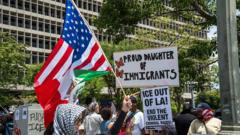In an effort to tighten immigration, President Donald Trump's administration is ramping up its deportation efforts, resulting in significant anxiety among business owners and immigrant workers alike. Victor Moran, CEO of a Maryland cleaning company employing 1,200 workers, has seen a dwindling workforce and the departure of around 15 workers after Trump lifted temporary protections for immigrants from Venezuela and Nicaragua. The impact can worsen if the government targets additional work permits, leading businesses to potentially lose hundreds of critical staff members who are central to their operations.
The importance of immigrant labor is underscored by recent census data, which indicates nearly 20% of the US workforce is foreign-born, marking a historic high since 1994. Trump's targeting of undocumented immigrants—who make up roughly 4% of the overall labor force—poses a significant risk to job availability and economic growth. This has also resonated with various American industries that are already feeling the effects; companies across the nation express concern that without sufficient immigrant labor, their growth will slow, severely limiting their operational capabilities.
Emotions run high for many immigrants, such as Justino Gomez, a long-time resident from El Salvador authorized to work under Temporary Protected Status (TPS). Gomez, who supports an adopted daughter back in El Salvador, fears for his fate and the continuity of his work status as immigration policies take a more aggressive turn. The fear of deportation transcends beyond personal anxiety; it also translates into a chilling effect on the economy. Economists, including Giovanni Peri from the University of California, Davis, argue that the labor market's contraction could lead to inflationary pressures, making it difficult for firms to attract employees due to increased competition among businesses.
Industry leaders, such as Adam Lampert from Cambridge Caregivers in Texas, highlight the practical ramifications of the ongoing policy changes. With around 80% of his staff being foreign-born, Lampert faces challenges in filling vacant roles. The situation threatens to create further inflation as businesses are forced to raise their rates to keep up with heightened labor demands. Moreover, projections for sectors like healthcare predict that training American workers for these roles will take time, while the population's needs continue to surge.
Trump's policy measures have not gone unchallenged. Legal actions against these measures have been initiated, with questions lingering about the sustainability of the current course. Meanwhile, sectors such as homebuilding report declining manpower as work crews withdraw. The National Association of Homebuilders is advocating for immigration reforms to accommodate labor needs, yet expectations for rapid changes seem pessimistic.
The ongoing dialog around immigration and workforce dynamics in the United States continues to evolve amidst these pressures, suggesting profound implications for the future economic landscape.
The importance of immigrant labor is underscored by recent census data, which indicates nearly 20% of the US workforce is foreign-born, marking a historic high since 1994. Trump's targeting of undocumented immigrants—who make up roughly 4% of the overall labor force—poses a significant risk to job availability and economic growth. This has also resonated with various American industries that are already feeling the effects; companies across the nation express concern that without sufficient immigrant labor, their growth will slow, severely limiting their operational capabilities.
Emotions run high for many immigrants, such as Justino Gomez, a long-time resident from El Salvador authorized to work under Temporary Protected Status (TPS). Gomez, who supports an adopted daughter back in El Salvador, fears for his fate and the continuity of his work status as immigration policies take a more aggressive turn. The fear of deportation transcends beyond personal anxiety; it also translates into a chilling effect on the economy. Economists, including Giovanni Peri from the University of California, Davis, argue that the labor market's contraction could lead to inflationary pressures, making it difficult for firms to attract employees due to increased competition among businesses.
Industry leaders, such as Adam Lampert from Cambridge Caregivers in Texas, highlight the practical ramifications of the ongoing policy changes. With around 80% of his staff being foreign-born, Lampert faces challenges in filling vacant roles. The situation threatens to create further inflation as businesses are forced to raise their rates to keep up with heightened labor demands. Moreover, projections for sectors like healthcare predict that training American workers for these roles will take time, while the population's needs continue to surge.
Trump's policy measures have not gone unchallenged. Legal actions against these measures have been initiated, with questions lingering about the sustainability of the current course. Meanwhile, sectors such as homebuilding report declining manpower as work crews withdraw. The National Association of Homebuilders is advocating for immigration reforms to accommodate labor needs, yet expectations for rapid changes seem pessimistic.
The ongoing dialog around immigration and workforce dynamics in the United States continues to evolve amidst these pressures, suggesting profound implications for the future economic landscape.























